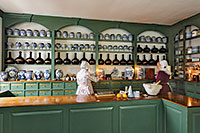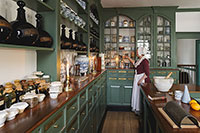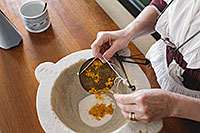Page content
A Dose of Expertise
Apothecary shop's longtime employees bring depth to medical interpretation
by Nicole Trifone
Photography by Dave Doody
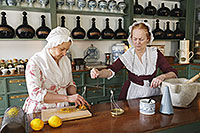
Robin Kipps holds the scale as Sharon Cotner weighs orange peel used in an 18th-century treatment re-created at the Pasteur & Galt Apothecary Shop.
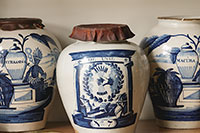
Antique jars lining the walls of the Pasteur & Galt Apothecary contain medical treatments and other items - a range of products one can find in modern pharmacies.
A woman walked into the Pasteur & Galt Apothecary Shop on Duke of Gloucester Street, and putting herself into an 18th-century state of mind, she approached the interpreter behind the counter. After a quick chat about the shop, the visitor began listing hypothetical symptoms.
Severe headache. Sensitivity to light. Nausea.
Robin Kipps, who has studied 18th-century medical practices since she began working in the shop in 1983, turned to the dozens of antique drug jars — each labeled in Latin — lining the walls. She reached for a jar of coffee beans and placed it on the counter.
"An apothecary would've told you to drink this," she said, reciting advice that would have been given in the 1700s.
Apothecaries, who were trained to diagnose, prescribe and produce treatments through an apprenticeship, acted as doctors in the 18th century. They knew little about chemistry but figured out treatments that could address certain symptoms through trial and error — and observation. Though the medical community had not yet discovered caffeine or its properties, for example, apothecaries noticed people who suffered from severe headaches often felt better after drinking a cup of coffee. It was discovered much later that caffeine does not always work to treat this condition.
Apothecary shops in Colonial America sold many remedies, most of which were imported into Great Britain from around the world. Patients could purchase these remedies along with household items, like toothbrushes, that might be found in today's pharmacies. Eighteenth-century shoppers might also have found tobacco and spices.
The apothecary shop in the Historic Area, which stands on the same site as the 18th-century Pasteur & Galt Apothecary Shop, is staffed by two full-time interpreters — Kipps and Sharon Cotner, who began working there in 1984. Three volunteers — Jim Magill, who has volunteered in the shop for more than 15 years; Dr. Robert Jaffee, an ophthalmologist; and Henry Kozek, a registered pharmacist — help them run the shop.
Kipps and Cotner did not realize they were launching careers when they accepted their jobs with The Colonial Williamsburg Foundation.
Cotner ended up in Williamsburg on a lark. After a summer job at a Girl Scout camp in Virginia ended, Cotner's co-workers — who were students at the College of William & Mary — persuaded her to come to Williamsburg, and she arrived with no particular job in mind. Kipps actually came in pursuit of a summer job. A lover of museums since childhood, she had visited many with her military family in their travels around the country.
Each armed with a degree in psychology, the two women worked for Colonial Williamsburg in different capacities before landing their posts in the apothecary shop, where they have remained for more than 30 years. Their passion for public speaking, education and science continues to fuel their excitement about their work.
Before Kipps and Cotner joined the apothecary staff, medical interpretation in the Historic Area focused on the basic information known about practices from the 18th century. The apothecary shop answered guests' questions with rudimentary knowledge and memorized facts about medical history of the period because specialized training and research were not yet available to staff in their shop.
Kipps and Cotner joined two other longtime interpreters, Susan Pryor and Kris Dippre, to build a more robust interpretation of the apothecary. Their teamwork and mixture of interests — two had science backgrounds, one studied history and another had journalism experience — yielded a deeper, more accurate understanding of late-18th-century medical practices and specialties and their place in history. The group worked together for more than 20 years before both Pryor and Dippre left the Foundation in 2007.
"We became invested in studying the subject ourselves, re-creating medicines, learning about techniques and procedures," Cotner said. "Each individual brought their own strengths and interests to the shop, but what we had in common is we were all extremely self-motivated. It really was magic in a bottle for many years."
Their research quickly influenced how the interpreters talked to guests. They discovered that much of the medical history centered on the early 1700s, much earlier than the period interpreted in the Historic Area. Over time, the team expanded the medical interpretation to include the reproduction of medicines, a richer understanding of the various medical specialties and the most accurate information on late-18th-century medicine known today.
Now, with decades of experience under their belts and a team of volunteers with their own medical expertise, the apothecary shop team's deep knowledge of medical practices allows them to field questions from guests who may feel a level of medical expertise themselves — everyone has suffered ailments and consulted doctors throughout their lives, after all.
While medical historians are often broken up into two camps — clinical and social — Kipps and Cotner must have their feet in both in order to address the wide spectrum of questions, all in an effort to place 18th-century medicine in proper historical and social context.
"We want people to look at medical history two ways: through the eyes of an 18th-century person — what did they know and why are they doing the things that they're doing — and then get them to look at it from a modern standpoint," Kipps said.
Over the years, apothecary interpreters have discussed muscle loss with a NASA scientist, answered questions from fourth-graders curious about 18th-century hygiene and chatted about domestic medicine with parents whose children recently suffered an illness.
"Most of the time, it's a general discussion of science. In order to put medicine in perspective, you have to understand the state of science itself and how it evolved," Cotner said. "We have to know about pharmacy, surgery, diagnostics, treatment and equipment. Then there are the different specialties, which weren't always separate categories — dentistry, midwifery, even aspects of veterinary medicine."
In addition to teaching guests about diagnosis and treatment in the late 1700s, the apothecary interpreters share 18th-century Williamsburg's social medical history — the story of the partnership between apothecary-surgeons Dr. John Minson Galt, who was a visiting physician at the Public Hospital, and Dr. William Pasteur and their place in the Williamsburg medical community. They also discuss the medical effects of citizens' habits and living conditions and how the white medical community and the African American and Native American cultures interacted.
As members of a handful of prominent medical associations, Kipps and Cotner have used their networks, attended lectures, visited other museums and continually researched to become experts in 18th-century medicine.
The Pasteur & Galt Apothecary Shop is open to Colonial Williamsburg guests five days a week and regularly hosts school and tour groups, offering a snapshot of Colonial life that guests may not see anywhere else in the Historic Area.
"Everybody gets sick. Everybody uses treatments to get better. Health wellness is simply relevant to our existence, no matter the time period," Cotner said. "If you want to understand society back then, knowing how they treated illnesses is integral to understanding everyday life."

